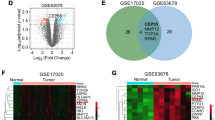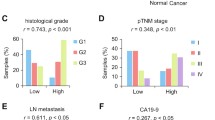Abstract
Centrosomal protein 55 (CEP55) is the latest found member in the centrosomal relative protein family, which participates in cell-cycle regulation. CEP55 exists in many kinds of normal tissues and tumour cells such as hepatocellular carcinoma, and is important in carcinogenesis. However, the role of CEP55 in the pathogenesis of gastric cancer (GC) remains unclear. The mRNA levels of CEP55 in GC tissues and GC cell lines were examined by quantitative real-time PCR, and the protein expression of CEP55 in GC tissues was detected by Western blot and immunohistochemistry. The role of CEP55 in regulating the proliferation of GC cell lines was investigated both in vitro and in vivo. CEP55 was strongly upregulated in human GC, indicating that CEP55 contributed to carcinogenesis and progression of GC. Ectopic overexpression of CEP55 enhanced the cell proliferation, colony formation, and tumourigenicity of GC cells, whereas CEP55 knockdown inhibited these effects. We discovered that cell transformation induced by CEP55 was mediated by the AKT signalling pathway. Overexpression of CEP55 enhanced the phosphorylation of AKT and inhibited the activity of p21 WAF1/Cip1. In addition, cellular proliferation was suppressed as a result of cell cycle arrest at the G2/M phase in CEP55-knockdown cells. CEP55 expression was elevated in GC compared with normal control tissues. Credible evidence showed that CEP55 can be a potential therapeutic target in GC.






Similar content being viewed by others
References
Jemal A, Bray F, Center MM, Ferlay J, Ward E, Forman D. Global cancer statistics. CA Cancer J Clin. 2011;61(2):69–90. doi:10.3322/caac.20107.
Ferlay J, Shin HR, Bray F, Forman D, Mathers C, Parkin DM. Estimates of worldwide burden of cancer in 2008: GLOBOCAN 2008. Int J Cancer. 2010;127(12):2893–917. doi:10.1002/ijc.25516.
Hartgrink HH, Jansen EP, van Grieken NC, van de Velde CJ. Gastric cancer. Lancet. 2009;374(9688):477–90. doi:10.1016/S0140-6736(09)60617-6.
Pennathur A, Farkas A, Krasinskas AM, Ferson PF, Gooding WE, Gibson MK, et al. Esophagectomy for T1 esophageal cancer: outcomes in 100 patients and implications for endoscopic therapy. Ann Thorac Surg. 2009;87(4):1048–54. doi:10.1016/j.athoracsur.2008.12.060. discussion 54–5.
Jiang B, Li Z, Zhang W, Wang H, Zhi X, Feng J, et al. miR-874 inhibits cell proliferation, migration and invasion through targeting aquaporin-3 in gastric cancer. J Gastroenterol. 2013. doi:10.1007/s00535-013-0851-9.
Fabbro M, Zhou B-B, Takahashi M, Sarcevic B, Lal P, Graham ME, et al. Cdk1/Erk2- and Plk1-dependent phosphorylation of a centrosome protein, Cep55, is required for its recruitment to midbody and cytokinesis. Dev Cell. 2005;9(4):477–88. doi:10.1016/j.devcel.2005.09.003.
Zhao WM, Seki A, Fang G. Cep55, a microtubule-bundling protein, associates with centralspindlin to control the midbody integrity and cell abscission during cytokinesis. Mol Biol Cell. 2006;17(9):3881–96. doi:10.1091/mbc.E06-01-0015.
Chen CH, Lu PJ, Chen YC, Fu SL, Wu KJ, Tsou AP, et al. FLJ10540-elicited cell transformation is through the activation of PI3-kinase/AKT pathway. Oncogene. 2007;26(29):4272–83. doi:10.1038/sj.onc.1210207.
Martinez-Garay I, Rustom A, Gerdes HH, Kutsche K. The novel centrosomal associated protein CEP55 is present in the spindle midzone and the midbody. Genomics. 2006;87(2):243–53. doi:10.1016/j.ygeno.2005.11.006.
Sakai M, Shimokawa T, Kobayashi T, Matsushima S, Yamada Y, Nakamura Y, et al. Elevated expression of C10orf3 (chromosome 10 open reading frame 3) is involved in the growth of human colon tumor. Oncogene. 2005. doi:10.1038/sj.onc.1209051.
Chen CH, Chien CY, Huang CC, Hwang CF, Chuang HC, Fang FM, et al. Expression of FLJ10540 is correlated with aggressiveness of oral cavity squamous cell carcinoma by stimulating cell migration and invasion through increased FOXM1 and MMP-2 activity. Oncogene. 2009;28(30):2723–37. doi:10.1038/onc.2009.128.
Blagosklonny MV, Chen C-H, Lai J-M, Chou T-Y, Chen C-Y, Su L-J, et al. VEGFA upregulates FLJ10540 and modulates migration and invasion of lung cancer via PI3K/AKT pathway. PLoS ONE. 2009;4(4):e5052. doi:10.1371/journal.pone.0005052.
Chang Y-C, Chen Y-J, Wu C-H, Wu Y-C, Yen T-C, Ouyang P. Characterization of centrosomal proteins Cep55 and pericentrin in intercellular bridges of mouse testes. Journal of Cellular Biochemistry. 2010:n/a-n/a. doi:10.1002/jcb.22517.
Brazil DP, Park J, Hemmings BA. PKB binding proteins. Getting in on the Akt. Cell. 2002;111(3):293–303.
Whiteman EL, Cho H, Birnbaum MJ. Role of Akt/protein kinase B in metabolism. Trends Endocrinol Metab. 2002;13(10):444–51.
Liang J, Slingerland JM. Multiple roles of the PI3K/PKB (Akt) pathway in cell cycle progression. Cell Cycle. 2003;2(4):339–45.
Testa JR, Tsichlis PN. AKT signaling in normal and malignant cells. Oncogene. 2005;24(50):7391–3. doi:10.1038/sj.onc.1209100.
Altomare DA, Testa JR. Perturbations of the AKT signaling pathway in human cancer. Oncogene. 2005;24(50):7455–64. doi:10.1038/sj.onc.1209085.
Abbas T, Dutta A. p21 in cancer: intricate networks and multiple activities. Nat Rev Cancer. 2009;9(6):400–14. doi:10.1038/nrc2657.
Elledge SJ. Cell cycle checkpoints: preventing an identity crisis. Science. 1996;274(5293):1664–72.
Sherr CJ. Cancer cell cycles. Science. 1996;274(5293):1672–7.
Clurman BE, Roberts JM. Cell cycle and cancer. J Natl Cancer Inst. 1995;87(20):1499–501.
Delattre M. The arithmetic of centrosome biogenesis. J Cell Sci. 2004;117(9):1619–30. doi:10.1242/jcs.01128.
Srsen V. Merdes A. Cell Div. 2006;1(1):26. doi:10.1186/1747-1028-1-26.
Sankaran S, Parvin JD. Centrosome function in normal and tumor cells. J Cell Biochem. 2006;99(5):1240–50. doi:10.1002/jcb.21003.
Cantley LC. The phosphoinositide 3-kinase pathway. Science. 2002;296(5573):1655–7. doi:10.1126/science.296.5573.1655.
Markman B, Atzori F, Perez-Garcia J, Tabernero J, Baselga J. Status of PI3K inhibition and biomarker development in cancer therapeutics. Ann Oncol. 2010;21(4):683–91. doi:10.1093/annonc/mdp347.
Hanahan D, Weinberg RA. The hallmarks of cancer. Cell. 2000;100(1):57–70. doi:10.1016/S0092-8674(00)81683-9.
Chen YL, Law PY, Loh HH. Inhibition of akt/protein kinase B signaling by naltrindole in small cell lung cancer cells. Cancer Res. 2004;64(23):8723–30. doi:10.1158/0008-5472.CAN-03-3091.
Xu X, Sakon M, Nagano H, Hiraoka N, Yamamoto H, Hayashi N, et al. Akt2 expression correlates with prognosis of human hepatocellular carcinoma. Oncol Rep. 2004;11(1):25–32.
Nakanishi K, Sakamoto M, Yamasaki S, Todo S, Hirohashi S. Akt phosphorylation is a risk factor for early disease recurrence and poor prognosis in hepatocellular carcinoma. Cancer. 2005;103(2):307–12. doi:10.1002/cncr.20774.
Yohn NL, Bingaman CN, DuMont AL, Yoo LI. Phosphatidylinositol 3′-kinase, mTOR, and glycogen synthase kinase-3β mediated regulation of p21 in human urothelial carcinoma cells. BMC Urol. 2011;11(1):19. doi:10.1186/1471-2490-11-19.
Lin HP, Jiang SS, Chuu CP. Caffeic acid phenethyl ester causes p21 induction, Akt signaling reduction, and growth inhibition in PC-3 human prostate cancer cells. PLoS One. 2012;7(2):e31286. doi:10.1371/journal.pone.0031286.
Mullany LK, Nelsen CJ, Hanse EA, Goggin MM, Anttila CK, Peterson M, et al. Akt-mediated liver growth promotes induction of cyclin E through a novel translational mechanism and a p21-mediated cell cycle arrest. J Biol Chem. 2007;282(29):21244–52. doi:10.1074/jbc.M702110200.
Archer SY, Johnson J, Kim HJ, Ma Q, Mou H, Daesety V, et al. The histone deacetylase inhibitor butyrate downregulates cyclin B1 gene expression via a p21/WAF-1-dependent mechanism in human colon cancer cells. Am J Physiol Gastrointest Liver Physiol. 2005;289(4):G696–703. doi:10.1152/ajpgi.00575.2004.
Brehm A, Miska EA, McCance DJ, Reid JL, Bannister AJ, Kouzarides T. Retinoblastoma protein recruits histone deacetylase to repress transcription. Nature. 1998;391(6667):597–601. doi:10.1038/35404.
Alt JR, Gladden AB, Diehl JA. p21(Cip1) promotes cyclin D1 nuclear accumulation via direct inhibition of nuclear export. J Biol Chem. 2002;277(10):8517–23. doi:10.1074/jbc.M108867200.
Lin J, Reichner C, Wu X, Levine AJ. Analysis of wild-type and mutant p21WAF-1 gene activities. Mol Cell Biol. 1996;16(4):1786–93.
Nakanishi M, Robetorye RS, Adami GR, Pereira-Smith OM, Smith JR. Identification of the active region of the DNA synthesis inhibitory gene p21Sdi1/CIP1/WAF1. EMBO J. 1995;14(3):555–63.
Acknowledgments
This work was partially supported by the National Natural Science Foundation of China (81272712, 81072031, 81101802), the Program for Development of Innovative Research Team in the First Affiliated Hospital of NJMU, the Priority Academic Program Development of Jiangsu Higher Education Institutions (PAPD, JX10231801) and the translational research of early diagnosis and comprehensive treatment in pancreatic cancer (The research Special Fund For public welfare industry of health, 201202007)
Conflicts of interest
None.
Author information
Authors and Affiliations
Corresponding author
Additional information
Jinqiu Tao and Xiaofei Zhi contributed equally to this work.
Rights and permissions
About this article
Cite this article
Tao, J., Zhi, X., Tian, Y. et al. CEP55 contributes to human gastric carcinoma by regulating cell proliferation. Tumor Biol. 35, 4389–4399 (2014). https://doi.org/10.1007/s13277-013-1578-1
Received:
Accepted:
Published:
Issue Date:
DOI: https://doi.org/10.1007/s13277-013-1578-1




